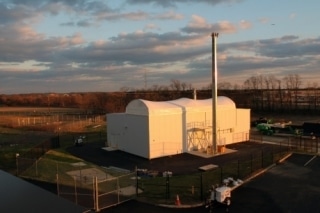Mar 29 2016
Objects in space will soon be monitored by a radar array for the U.S. Air Force’s Space Fence as part of Lockheed Martin’s new test site representative of the larger system under construction on the remote Kwajalein Island.
 The Space Fence testing facility is representative of the larger Gallium Nitride (GaN)-based system under construction on the Marshall Islands. This innovative system will transform the way the United States Air Force monitors thousands of pieces of orbital debris in space. (Photo courtesy Lockheed Martin)
The Space Fence testing facility is representative of the larger Gallium Nitride (GaN)-based system under construction on the Marshall Islands. This innovative system will transform the way the United States Air Force monitors thousands of pieces of orbital debris in space. (Photo courtesy Lockheed Martin)
The test facility will be used for early validation of hardware, firmware and software that will enable the Space Fence to detect, track, and catalog orbital objects more than 1.5 million times a day to predict and prevent space-based collisions. The test site will also provide early lessons learned on installation of the S-band ground-based radars, support maintenance training and allow engineers to test verification procedures.
The New Jersey test site officially opened during a ceremony attended by representatives from the U.S. Air Force, local, state and federal governments, Lockheed Martin leaders and Space Fence team members.
“The opening of this test facility marks an exciting milestone for Space Fence,” says Bruce Schafhauser, director, Lockheed Martin Space Fence. "We are one step closer to dramatically improving space situational awareness and increasing orbital debris monitoring by tenfold. By using an open-architecture system, Space Fence can adapt to future missions requiring various tracking and coverage approaches.”
Within the Space Fence radar design, Lockheed Martin uses the latest monolithic microwave integrated circuit technology, including Gallium Nitride (GaN) semiconductor materials. GaN provides significant advantages for active phased array radar systems, including higher power density, greater efficiency and improved reliability over previous technologies.
Construction continues at the six-acre Space Fence site 2,100 miles southwest of Honolulu. Forty-five hundred cubic yards of concrete now form the foundation of the sensor site and the start of ring walls (left) that will support the inflatable roof permeable by RF bands.
Once construction is complete, Space Fence will be tested and validated before its Initial Operating Capability occurs in late 2018.
For additional information, visit our website: www.lockheedmartin.com/spacefence.